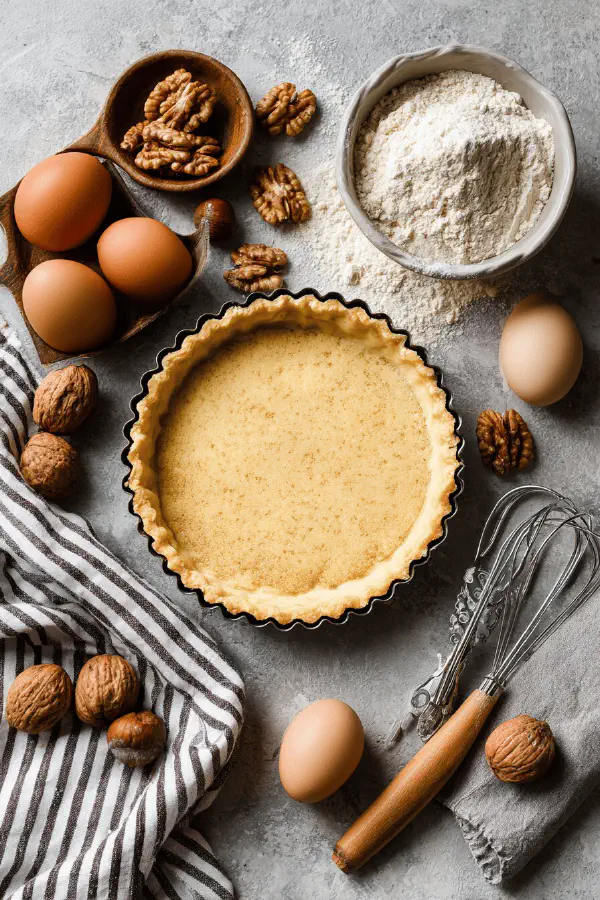Featured Recipe
Almond Sugar Tart Dough

By Kate
"
Sweet tart dough elevated with hazelnut flour and brown sugar, creating a tender, flavorful crust. Works well for small tarts, sturdy yet delicate. Swapping classic powdered sugar for brown introduces moisture and a hint of caramel. Hazelnut flour replaces almond powder, offering a deeper nut profile and richer crumb. Essential to chill dough thoroughly to avoid shrinkage. Watch dough texture — too dry, it cracks; too wet, becomes sticky. Bake until edges golden, surface matte with tiny cracks. A must-know for tart lovers aiming for a tender base with subtle nutty notes.
"
Prep:
30 min
Cook:
15 min
Total:
45 min
Serves:
8 servings
tarts
French pastry
baking basics
Introduction
Brown sugar and hazelnut flour. More than almond powder and powdered sugar. The caramel notes from brown sugar moisten this pâte sucrée, making it tender, not crumbly. Hazelnuts lend a deeper flavor, richer aroma — subtle but noticeable. Don’t overlook resting dough. Chill is your friend here. It tightens gluten strands, keeps butter cool. Roll outs firm, no stick. Handling too much? Dough loses structure. Freeze tart cases before baking — magic trick. Stops shrinking, keeps edges sharp. Oven temp moderate, not scorching. Too hot, crust cracks and browns unevenly. Watch the texture carefully during mixing — dough reads you as much as recipe. Lastly, always let shells cool fully. Warm crust absorbs wet fillings like a sponge; cold retains crunch.
Ingredients
About the ingredients
Butter should be softened but not melty — raw butter temperature affects dough texture drastically. Brown sugar is sifted lightly to avoid lumps; adds moisture unlike powdered sugar, so flour reduced slightly. Hazelnut flour swaps almond powder for an earthier, richer nuttiness and better oil content. Eggs combine structure and moisture; separate whisking ensures even incorporation. Flour sifted to avoid lumps and overworking; prevent tough dough. If you lack hazelnut flour, finely ground toasted hazelnuts work. Brown sugar can be light or dark according to taste but darker sugars increase moisture. Store dough wrapped tightly to avoid drying. If dough too sticky after mixing, dust fingers lightly with flour rather than adding more to dough — kills tenderness.
Method
Technique Tips
Begin by creaming butter and sugar until soft, uniform, and pale yellow; this aeration helps texture. Adding flour gently in batches ensures crumbly but cohesive mix. Over stirring at this point develops gluten, making crust tough. Egg-hazelnut mix adds nutty fragrance and binds crumb gently. Sable technique — rubbing dough between fingers breaks chunks, releasing butter uniformly without melting it, essential for tender shortcrust. Knead very briefly, just enough to bring dough into ball without overworking. Wrap and chill minimum 3 hours; longer resting firms dough, prevents shrinkage and tough texture. Roll dough evenly; irregular thickness leads to uneven baking. Freezing shells before baking prevents dough from sagging in oven. Baking time and temp adjusted to avoid burning brown sugar sugars early. Remove and cool on rack — hot shells can warp or become soggy from trapped steam.
Chef's Notes
- 💡 Use room temp butter, not melted. This ensures aeration when creaming with sugar. Fluffy is key. Under-whisking makes dense crust.
- 💡 Chill the dough. Resting is not an option. It firms up butter, making rolling easier. Shrinking causes more issues during baking.
- 💡 Texture checks matter. Too dry means cracking; too wet leads to stickiness. Adjust with flour lightly, don’t dump and mix.
- 💡 Use plastic wrap tight. Keeping dough from air stops drying out. Can freeze if prepping ahead; keeps shape better.
- 💡 Roll evenly. Irregular thickness leads to uneven baking. Watch edges, make them neat. Trim excess for sharp appearances.
Kitchen Wisdom
How to fix dry dough?
Add tiny splashes of water slowly. Use fingers to mix in gently. Too much could ruin texture.
What if dough sticks?
Dust lightly with flour on surfaces, also hands. Avoid adding too much; wrong texture results.
How long to chill?
Minimum three hours, longer is better. Allowing butter to firm up enough makes rolling easier.
Can I use different nuts?
Yes, sub hazelnut with finely ground almonds or toasted walnuts. Adjust accordingly for moisture.



